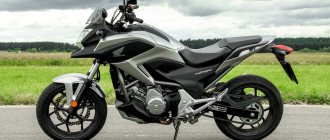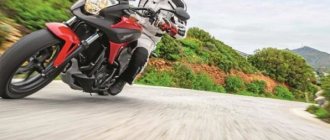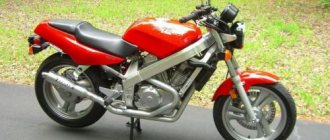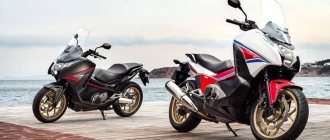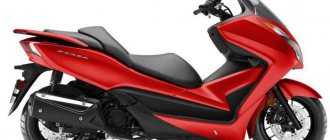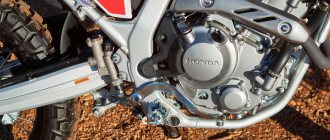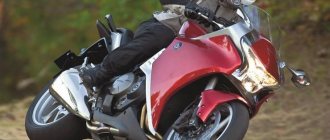14K 6 min.
Is it really possible to buy a new crossover with an automatic transmission, and from a respected Japanese brand, for less than half a million rubles? Don't even argue - it's absolutely real. True, it will not be a car, but a motorcycle.
Previous photo
Many motorcyclists, contrary to traffic rules, use high beam headlights during the day to be more visible.
Photo: Kommersant / Dmitry Lebedev / buy photo
Although the windshield is tiny, the effect of its presence is clearly noticeable, especially at high speeds
Photo: Kommersant / Dmitry Lebedev / buy photo
Carrying luggage options on a motorcycle are limited, but special accessories can go a long way toward solving this problem.
Photo: Kommersant / Dmitry Lebedev / buy photo
Next photo
1 / 3
Many motorcyclists, contrary to traffic rules, use high beam headlights during the day to be more visible.
Photo: Kommersant / Dmitry Lebedev / buy photo
Although the windshield is tiny, the effect of its presence is clearly noticeable, especially at high speeds
Photo: Kommersant / Dmitry Lebedev / buy photo
Carrying luggage options on a motorcycle are limited, but special accessories can go a long way toward solving this problem.
Photo: Kommersant / Dmitry Lebedev / buy photo
VASILY OSTROVSKY
Who's against it?
In our market, which is flooded with old “square” sportbikes, it is even more difficult to find a universal motorcycle. It seemed that the M1NSK Goose fits the concept of a universal bike well: 400 cc, lightweight, but with enough engine for the track. Not a bad option, but also economical. But it costs $3,000 new, and how it will fare with spare parts is a big question. And this is one cylinder, not two. Usually these motorcycles have strong vibrations, which become annoying on a long journey.
Aprilia Pegaso and BMW F650GS are two related motorcycles. And there is an even more recent F800GS. Moreover, BMW is popularly called a “goose”, or more precisely a “caterpillar”, which is where the name M1NSK comes from. Our marketers. But the former consume about 6 liters per “hundred”, which is not particularly economical. In addition, there are some nuances with the Rotax engine, such as the overrunning clutch, which periodically requires replacement. And again, this is one cylinder - there are more vibrations. The more recent twin-cylinder F800GS? A good option. But in the used market it is more expensive than the Honda NC700X.
About the diversity of species
In the world of motorcycles, the same processes are now seething as in the automobile market - the active mixing of different classes and the development of newly formed niches. The traditional classification is bursting at the seams, unable to cope with the influx of new models that do not fit into the existing canons. For example, crossovers are a relatively new genre for the two-wheeled industry. As you might guess, a crossover should be understood as a purely highway vehicle, which is endowed with some features characteristic of off-road vehicles. The Honda NC750XD readily fits into this format: it is stylized as a serious touring enduro (the beak under the headlight alone is worth it), moreover, compared to ordinary asphalt motorcycles, it has a slightly increased ground clearance and slightly longer-travel suspensions. In general, the appropriate surroundings are present, and no one demands more from an SUV.
Apparently, the development of the NC family of motorcycles (in addition to the NC750XD crossover, it includes the NC750S naked bike and the Integra maxi-scooter) was initiated more by marketers than by engineers. It turns out that a sociological study was conducted and it turned out that 90% of owners of medium-sized vehicles do not risk accelerating faster than 140 km/h and, moreover, do not like to spin the engine above 6000 rpm. This means they need, how can I put it, a more “automotive” motorcycle. Okay, no problem - everyone can do it at Honda.
Decent ground clearance allows you not to be too careful when driving on curbs
Photo: Dmitry Lebedev, Kommersant
The two-cylinder engine, designed specifically for NC, is truly similar in characteristics to a car. By motorcycle standards, it turned out to be low-boosted: 745 cc were given only 54 horsepower. For comparison: 600 cc sportbikes have long crossed the hundred horsepower mark. But the new engine has smooth traction throughout the entire rev range, while the “sports” only begin their life at the eight thousandth mark on the tachometer - where the NC750XD’s red zone already ends.
The most interesting thing is that this engine doesn’t just look like a car’s – it actually is a car’s! This is “half” of the power unit from the Honda Jazz hatchback - the engines are unified according to the cylinder-piston group. The engine is installed with a fair inclination forward, thanks to which the center of gravity is quite low, even despite the general “elevation” of the motorcycle above the ground. And this is good: you can safely count on decent maneuverability and decent handling.
By the way, the bike is similar to a four-wheeled vehicle not only in the origin of the engine, but also in a number of other features: combined brakes with an anti-lock braking system, the presence of a lockable trunk and an automatic transmission. Actually, it was the operation of the transmission that became the most interesting item on the driving menu for me.
Engineers have been making attempts to save the rider from manipulating the gearbox for more than half a century. For example, in 1952, Ducati launched the Cruiser 175 scooter, which was equipped with a torque converter automatic transmission. This model was not particularly popular: the public was distrustful of such an advanced technology. In the mid-70s, the Italians and Japanese introduced motorcycles with automatic transmissions almost simultaneously, but the Moto Guzzi V1000 Convert and Honda CB750A Hondamatic were still too imperfect to conquer the market. With the advent of the new century, experiments continued: in 2003, the Italian company Gilera released the Ferro 850 concept bike, which formed the basis for the Aprilia Mana 850 production model, where the transmission of torque to the rear wheel was controlled by a variator. And only after that Honda perked up, taking the situation into its own hands: in 2008, the Japanese created a futuristic cruiser DN-01 with an ingenious hydrostatic transmission, and a couple of years later the VFR1200FD sports tourer appeared, equipped with a preselective DCT (Dual Clutch Transmission) robot with two clutches . This is exactly the same box, only of the second generation, found on the NC750XD.
On the Russian Honda website, you should look for the NC750XB among the enduro, although in fact it is a purely road motorcycle
Photo: Dmitry Lebedev, Kommersant
How does it sit and how does it ride?
And now we actually present the NC700X. This is a “SUV”, that is, it is not yet a touring enduro, but it is no longer a street car. The seating position is high, but the legs can reach the ground even for short people. In this example, the seat is re-upholstered and stands higher; the standard bike has an even lower seat height. The motorcycle weighs just over 200 kg, but due to the low center of gravity it feels very light.
Practicality, practicality and practicality again. Instead of a tank there is a large helmet case, and the fuel tank is located under the rear seat, further reducing the center of gravity. There is a windshield, which, however, was completed by the owner, but on the highway it does not get blown away by the incoming air. There is a standard case, but this motorcycle has a non-standard one.
But the most interesting thing is the engine. Two cylinders, 669 cc, 50 horsepower, 5.5 seconds to “hundreds” and 185 km/h “maximum speed”. The “official” consumption is 3.5 liters, the real one is only 4! The two-cylinder engine is half the size of a Honda Jazz engine, revving at 6200 rpm, just like a car! The cylinders lie almost horizontally, tilted forward, which shifts the center of gravity even lower. That is, the motorcycle seems tall and in fact heavy, but it feels like a bicycle, it seems so light.
The motorcycle is just some kind of “diesel”: it pulls from the bottom like a beast, but the revs are low. The acceleration dynamics are impressive both in the city and on the highway. Although this is not a Yamaha R1, it’s understandable that some will find it “sluggish.” In Russia there is a club for NC700X lovers, where even the owners themselves call their motorcycles “Sluggish”. But everything is relative.
You can refill with car oil, and there are also versions with automatic transmission! On the highway the bike is very comfortable, at 100 km/h it only spins 3000 rpm and can click through 6 gears. The “maximum speed” is small by motorcycle standards; it doesn’t go 200 km/h. And it was very scary when I was changing lanes from the first lane to the third, and the engine reached the cutoff at 6200 rpm - and the motorcycle suddenly stopped accelerating, and I literally rested my hands on the steering wheel. But then you get used to these “diesel” habits and can no longer reach the cut-off point.
It is very comfortable to drive both on the highway and in the city. And the feeling of a light bike makes it possible to move comfortably along city streets. Low fuel consumption allows you to pay for gasoline at gas stations with coins. For those who need to ride and not show off, this is a great motorcycle.
The only thing that's terrible is the brakes. Perhaps something needs to be done about maintenance, but still the brakes are not this Honda’s biggest strong point. Slow down and pray - there is no other way. If there were two brake discs in front, the situation would be much better, alas...
Honda NC 700 (NC 750) motorcycle review
It is light, well-balanced, you can drive very slowly and not lose your balance, the traction is locomotive, it doesn’t jerk, the gears are switched intuitively, the brakes are excellent + ABS, the height of the mirrors and the width allows you to ride between the rows without straining.
I’ve owned it for two weeks, in the first five days I drove 1000 km around St. Petersburg, the first thing that pleased me was the consumption, for this 1000 km I refueled for 870 rubles. Traffic jams melt away, they don’t exist, the motorcycle is high, the handles are high exactly above the side mirrors of passenger cars)))) but at the level of jeeps and gazelles. The dynamics for 51 horses are excellent. For safe braking, ABS worked for me once, I only heard it work, there was no sensation of any discomfort! The machine works perfectly without any clunkiness like on a car!!!! I accelerated to 160, the tachometer showed 5000, the cutoff is at 6250, so I think 200 lying on the tank is the maximum for it. That seems to be all for now, don’t judge strictly, my personal opinion is an excellent moto for the city and short trips! And for beginners it’s just a fairy tale!!!
The general feeling is one of childish delight mixed with surprise. Delight because this device, in the version with automatic transmission, is controlled like a moped: nimble, light, the only controls you need are gas and brake (there is a forced gear shift on the left handle, but I never used it once during the entire 4 hours of the trip ). What is surprising is that this device is, after all, a motorcycle: it accelerates in seconds, you can jump off a curb without any problems (I rented the X modification), its engine does not experience the slightest problem with such things as driving up a hill from a standstill up a very steep climb (the moped I rented in the summer did not pass this test with me on board).
1. Engine. Logic dictates that there should be one, but it is almost inaudible. To hear the engine, you need to turn off the gas at the start as hard as you can, then the device will emit a bass “rrrrrrrr”. The rest of the time the engine does not manifest itself in any way: neither noise nor vibration.
2. Acceleration dynamics. Very soft and at the same time very worthy. What I mean: the motorcycle is capable of accelerating quickly, and much faster than it should be accelerating in the city, i.e. You still need to have a brain. At the same time, gear shifting occurs very smoothly, in “D” mode it instantly climbs into 6th gear, and the tachometer in the city dangles between 2000 and 3000 rpm. The dynamics of this motorcycle make it easy to get away from any intersection, which is why it is commonplace on it to bypass the queue at the intersection and get in first: this does not annoy car drivers; in any case, they will not be forced to wait until you accelerate. The engine pulls well from the bottom, there is no need to rev the engine to get away from the intersection. What you won’t be able to do with it is accelerate to 140, put it in a lower gear, turn the gas to the limit, and shoot on the autobahn: this is absolutely not a racing car by definition. On the autobahn the device feels quite decent, it doesn’t drag the rear, it reaches 150 easily and without strain. I didn't try again, because the tiny stock windshield doesn't help, and the car is still in the process of breaking in.
Separately, a few words about the automatic transmission: there is not a variator, like on mopeds, not a torque converter, but a robotic transmission. You don't notice her work. Those. at all. You pick up speed - something somewhere inside the motorcycle clicks and the indicator on the panel changes: “1..2…3…6”. You brake or just let off the gas - again something barely audibly clicks in the inside of the car, and the indicator changes: “6...5...4...1”. I stopped at a traffic light and the transmission automatically shifted into first gear. when the first light is on, you don’t need to hold the car with the brake, as in the case of a car: until you unscrew the gas handle at least a little, you will remain where you were. There are two buttons on the left handle for forced gear shifting up or down, but I never had the need to use them: the automatic mode suited me completely.
3. Braking: the device has one brake disc at the front and rear. It doesn’t know how to firmly dig into the asphalt when braking, like more serious models, but it doesn’t need that: I can’t imagine a situation where its standard brakes wouldn’t be enough. The car's ABS works flawlessly, although in order to check it, I had to look for a parking lot with a large puddle. The brakes also work very softly and predictably: if you press the brake a little, the car does not try to throw you forward, but simply squats a little harder.
3. Cost-effective. I was given a car with a full tank. I drove around the city for about 3.5 hours (including lunch and a trip to the store). So, the “stripe” indicator on the right side of the scoreboard did not decrease by a single strip during this time. At all. This car consumes absolutely ridiculous amounts of fuel, something like three liters per hundred.
4. Maneuverability. Oooooh... Aaaaaah.... Dust ist fantastic. "Traffic jams? During rush hour? No, I didn’t see it.” Row spacing is easy and relaxed. Avoid the queue in front of a traffic light, get in first and quickly leave the traffic light - no problem. Jumping off the curb is not a problem. The device is only slightly inferior to a bicycle in terms of maneuverability. An ideal car for getting around the city. You will only have to stand on it at a red traffic light; this car can squeeze through anywhere.
5. Fit and comfort. The seat could still be more comfortable, but, on the other hand, this is a city motorcycle for which there are no traffic jams: no one plans to sit on it for hours. The feeling from the seat is that you roll forward a little from it towards the steering wheel, I suspect that this can be treated with a tuned seat. You can see much more in the mirrors than, for example, the BMW GS 800, where I only saw the sleeves of my jacket. I was very disappointed by the helmet compartment, which is located on this motorcycle in place of the gas tank: my Schubert went in there with a good effort, on the third attempt, and I pulled him out of there with swear words and so-and-so’s mother. This is despite the fact that my helmet is not the maximum size. Well, it was worth making a 3 mm compartment. wider, huh? I was disappointed with the quality of the lid of this compartment and the seat lid of the second number: both lids were made, to put it mildly, on a budget and when closed they shake. The suspension of the device is quite soft, but considering what exactly this motorcycle is intended for, this is not critical. Yes, especially for long people: height over 190 cm is not a problem for boarding this device.
What this bike is NOT good for:
1. Show off. The engine doesn’t growl, it’s impossible to put it on the rear wheel, it’s impossible to do stoppies, there’s no chrome and glitter, the girls won’t turn their heads.
2. Find out who is cooler. This motorcycle easily moves away from an intersection from any car, but when I started from the intersection next to the Honda FireBlade, after a split second I saw it far ahead: as I wrote above, this car is not a sports motorcycle.
3. Solid, long range. No, it’s probably possible to hang panniers on it, and they will even hang, but this motorcycle is not for long-distance travel: a tiny windshield, a narrow rear, a moderate engine, a Spartan saddle.
Who is it ideal for:
1. Beginners will be completely and completely delighted with it. True, the automatic transmission is incredibly corrupting, but I must admit: it is very convenient.
2. “He who understands life is in no hurry” (c). If you don’t have a goal to impress anyone, but just need to go somewhere every day without wasting time in traffic jams, this is the ideal car. At the same time, traveling to a neighboring city if necessary will not be a problem.
Everything is fine, I bought it for my son to start with, I ended up driving about 7 thousand on my own, very nimble, the trunk is huge and comfortable. Two drawbacks - it’s terribly dead and expensive maintenance (and this is compared to a BMW, maintenance for 12,000 km is almost 18 thousand rubles, such as valve adjustment). And the robotic gearbox is contraindicated for getting through traffic jams - it is impossible to dose the clutch gas and at low speeds the motorcycle jerks, almost drove into the side of the car a couple of times.
So I drove the first 1000 km. The motorcycle so far satisfies all my needs.
Among the advantages, I would like to note: a comfortable fit, at least for my height, a very comfortable front lip in the false tank, the helmet fits completely, confidently holds the road and even on the removed asphalt goes exactly where you want, the wheel does not lead, quite fast acceleration to 160 , clear gear shifting and neutral is caught very well, I have already tested the ABS system when a car jumped out between the rows, it did an excellent job!!!
Of the minuses: there is an unpleasant vibration after 4500 rpm from 2 to 4 speeds, on the right footrest, on the fifth it was not noticed, which is very noticeable in motor boots with a hard sole, the location of the signal button is inconvenient, it is usually at the bottom, it often moves when the emergency lights are turned on you hit it, and it’s difficult to get into an emergency situation.
What about off-road?
It’s easy to ride through the forest, but due to alloy wheels and the lack of crankcase protection, you can’t compete with classic small-capacity enduros. There are tires with a universal pattern, which do not hum on the track and allow you to move more or less calmly on the sand. The pendants are soft, but difficult to break through. The handlebars are high, so you can comfortably stand in a stance to overcome obstacles. In general, light off-roading, primers - all this is easy for the NC700X.
You can install crankcase protection, but the clearance here is not the highest, but will become even lower. And it will need to be unscrewed when changing the oil, which is not very convenient. The filter can be changed from below, so the protection will have to be removed in any case.
⠀
Our verdict
The suspension is soft, the seating position is comfortable, the engine runs very smoothly and pulls well at any speed. It’s convenient to move around in the city, on the highway, and it’s not scary on the sand. Minus - the brakes are weak, it would need more power. Otherwise it would be the perfect motorcycle. But with an amendment - for those who need to ride, and not race or “show off”. Question price? It costs about $4,500 on average for a copy from 2012, that is, not much more expensive than the Goose from the “Motovelkos” F650GS, if it is in good condition. But cheaper than the newer “caterpillar” F800GS.
What alternatives to this motorcycle do you know?
